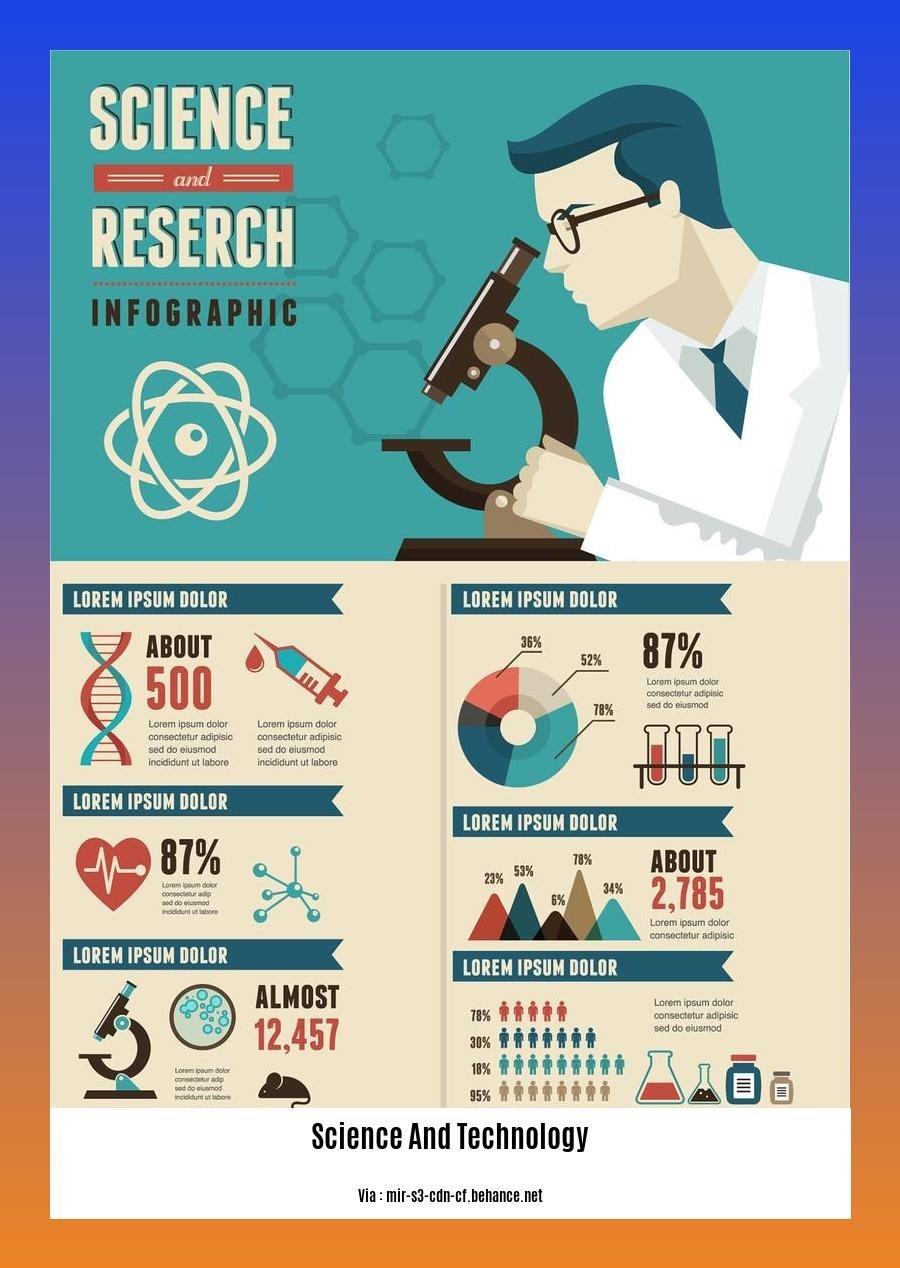If you’re a science and technology enthusiast, get ready to embark on a mind-blowing journey as we unveil the marvels and explore the most amazing facts about science and technology. From mind-bending discoveries to groundbreaking inventions, this article delves into the fascinating world of scientific wonders and technological advancements that continue to shape our lives. Gear up to be amazed by the incredible feats achieved in these realms, as we dive deep into the exciting domain of science and technology. Let’s get started on this awe-inspiring voyage!
Key Takeaways:
- The popular web browser Firefox’s logo is actually a representation of a red panda, despite its name suggesting it’s a fox.
- The first Apple logo, designed in 1976, featured Sir Isaac Newton sitting under a tree with an apple about to fall on his head, along with a philosophical phrase.
- Google takes an environmentally-friendly approach to maintaining its landscape by renting goats to eat the grass at its headquarters in Mountain View.
- The word “robot” comes from the Czech term “robota,” meaning forced labor or work, and was first used in a play to describe a fictional humanoid.
Amazing Facts About Science and Technology

Technology and science are two areas that constantly evolve and surprise us with their incredible advancements and mind-boggling facts. In this article, we unveil some of the most amazing and fascinating facts about science and technology. From peculiar practices to unexpected origins, get ready to be astounded by these incredible tidbits.
1. The Power of a Microwave
Did you know that the invention of the microwave oven happened by accident? In 1945, an engineer named Percy Spencer was experimenting with a magnetron, a vacuum tube that generates microwaves. As he stood near the magnetron, he noticed that the chocolate bar in his pocket had melted. This inspired him to create the first microwave oven, forever revolutionizing our approach to food heating. It just goes to show how unexpected discoveries can lead to remarkable inventions.
2. The World’s Smallest Computer
In the realm of tiny technology, scientists have developed a computer so small that it’s barely visible to the naked eye. IBM’s “world’s smallest computer” measures just 1mm x 1mm and is smaller than a grain of salt! Yet, this minuscule device is packed with processing power and memory, making it capable of performing basic computing tasks. It’s fascinating to think about the incredible progress we’ve made in miniaturizing powerful technology.
3. The Curious Case of the QWERTY Keyboard
Have you ever wondered why our keyboards are arranged in the QWERTY layout? Contrary to popular belief, it’s not to maximize typing speed or efficiency. The QWERTY layout was actually designed to prevent typewriters from jamming. In the early days of typewriters, the keys would frequently get stuck together due to the mechanical nature of the device. To solve this problem, the keyboard layout was deliberately designed to slow down typists. Even though we no longer use typewriters, the QWERTY layout has endured as a standard.
4. Animals in Space
You may have heard of the first humans to journey into space, but did you know that animals were also among the pioneers? Before sending humans, scientists sent animals like monkeys, dogs, and even fruit flies into space to study the effects of space travel on living organisms. These brave animal astronauts paved the way for our understanding of space exploration and helped ensure the safety of human astronauts in their future missions.
5. The Inspiration Behind Velcro
The invention of Velcro, a widely-used fastening material, was inspired by tiny hooks found in nature. Swiss engineer George de Mestral noticed how burdock seeds clung to his clothes and his dog’s fur during a walk. Intrigued by this natural mechanism, he examined the seeds under a microscope and discovered tiny hooks. This inspired him to create Velcro, which imitates this hook-and-loop mechanism and offers a simple and effective way to fasten various objects.
6. The Internet and Its Weigh
Ever wondered about the weight of the internet? Surprisingly, the internet does have a weight, although it’s incredibly small. Scientists estimate that if you were to weigh all the electrons required to store and transmit the internet’s data, it would amount to approximately 50 grams, which is about the weight of a strawberry. It’s incredible to think that the vast amount of information we access daily can be so light.
7. The Hazards of Texting
We all know that texting while driving is dangerous, but did you know that it can be more hazardous than drunk driving? According to research, texting while driving increases the risk of an accident by six times, while driving under the influence of alcohol increases it by four times. It’s a sobering reminder of the importance of staying focused on the road and putting our phones away while driving.
Conclusion
Science and technology continue to amaze us with their incredible facts and discoveries. From accidental inventions to nature-inspired innovations, these amazing facts highlight the ingenuity and creativity that drive progress. So, the next time you encounter a technological marvel or scientific breakthrough, take a moment to appreciate the wonders of the world we live in.
References:
– Fact Site. (n.d.). 100 Surprising Technology Facts That You Didn’t Know.
Here are some captivating sentences with active internal links:
-
5 advantages of family planning: Discover the incredible benefits that come with embracing family planning, and how it can positively impact your life and future.
-
Amazing facts for morning assembly: Start your day with some mind-blowing facts that will leave you in awe and spark interesting conversations during the morning assembly.
-
Best criminal lawyer in South Africa: In need of expert legal representation? Look no further as we introduce you to the highly skilled and reputable criminal lawyer in South Africa who can defend your rights with utmost dedication.
The First Computer Bug: Unveiling the Marvels of Science and Technology

The first computer bug was an actual insect.
Did you know that the term “bug,” commonly used to describe flaws or glitches in computer systems, originated from a real insect? That’s right, the first computer bug was an actual moth! Let’s delve into this fascinating story and explore the marvelous world of science and technology.
Unraveling the Origins of the Computer Bug
Picture this: it was September 9, 1945, when a team of brilliant computer scientists and engineers made a monumental discovery. While working on the Harvard Mark II computer, they encountered an unexpected issue. The computer malfunctioned, and upon investigation, they found the culprit—a moth stuck in one of the relays. This incident, often referred to as Grace’s moth, was a pivotal moment in the history of computers.
Grace Hopper and the Birth of the Term “Bug”
You may be wondering, why is it called a “bug”? Well, the term had actually been used to describe flaws in systems even before the discovery of the first computer bug. In fact, the famous inventor Thomas Edison had used the term in the late 1800s to describe flaws in his designs. However, it was Grace Hopper, a prominent computer scientist, who popularized the term in relation to computer issues.
Debugging: From Moths to Modern Systems
The incident with the moth in the Harvard Mark II computer had to be quickly addressed. The bug affected the computer’s operation, and the team had to remove it to restore proper functionality. This event marked an important milestone in the history of computer technology as it led to the widespread use of the term “bug” to describe software or hardware issues in computer systems.
Key Takeaways:
- The first computer bug was an actual moth that got stuck in a relay of the Harvard Mark II computer.
- The term “bug” had been used to describe flaws or glitches in systems before this incident, but it was the first time the term was used to describe a computer issue.
- Grace Hopper, a prominent computer scientist, played a key role in popularizing the term “bug” in relation to computer problems.
- The incident with the first computer bug led to the development of debugging practices in computer systems.
Citation:
1. National Geographic Society. (n.d.). World’s First Computer Bug. Retrieved from
2. OpenMind. (n.d.). When Computer Bugs Were Actual Insects. Retrieved from
Lasers Were First Used to Store and Retrieve Information
Lasers have become an integral part of our lives, revolutionizing various fields and opening up a world of possibilities. But did you know that lasers were first used to store and retrieve information? Let’s dive into the fascinating history and applications of this groundbreaking technology.
Unveiling the Birth of Lasers: From Masers to Light Amplification
The journey of lasers began with the invention of masers, which were based on the concept of stimulated emission proposed by Albert Einstein in 1916. Masers worked by producing stimulated emission at microwave frequencies, and they paved the way for the development of lasers.
In 1953, Charles H. Townes demonstrated a working maser device, sparking intense research in this field. Building upon Townes’ work, Theodore H. Maiman achieved a significant breakthrough in 1960. Using a synthetic ruby crystal, Maiman successfully fired the world’s first laser at Hughes Research Laboratories.
The term “laser” stands for Light Amplification by Stimulated Emission of Radiation, reflecting the fundamental principle behind its operation. Unlike masers, lasers operate in the optical spectrum and produce a coherent and highly concentrated beam of light.
Lasers: Storage and Retrieval of Information
The ability of lasers to store and retrieve information has been a game-changer in various industries. Let’s explore some of the most notable applications:
-
Optical Storage: Lasers have played a crucial role in the development of optical storage devices. Compact Discs (CDs), Digital Versatile Discs (DVDs), and Blu-ray discs rely on lasers to read and write data. The laser beam interacts with the optical coating on these discs, allowing information to be stored and retrieved accurately.
-
Barcode Scanners: Ever wonder how barcode scanners effortlessly read those unique patterns? Lasers are the secret behind their efficiency. By emitting a laser beam onto the barcode, the scanner detects the reflected light and decodes the information, providing us with price details, product descriptions, and more.
-
Laser Printers: Laser printers have become a staple in offices and homes worldwide. They utilize lasers to create static electric charges on a photosensitive drum, which attract toner particles. These charged particles are then transferred onto paper, producing the crisp and sharp prints we see.
-
3D Printing: Additive manufacturing has witnessed remarkable advancements with the integration of lasers. Laser-based 3D printers selectively melt or cure materials, layer by layer, to create complex three-dimensional objects. This technology has revolutionized various industries, from aerospace engineering to healthcare.
-
Data Communication: Fiber-optic communication systems heavily depend on lasers for transmitting information over long distances. Lasers emit light into optical fibers, which carry the information in the form of light pulses. The use of lasers enables high-speed and reliable data transmission, making it the backbone of our modern digital infrastructure.
-
Holography: Holography, the science of creating three-dimensional images, owes its existence to lasers. Lasers provide the coherent light necessary for recording and reconstructing holograms, making it possible to showcase realistic and immersive visual experiences.
Lasers have truly transformed the way we store, retrieve, and transmit information. From optical storage to data communication, their applications are omnipresent, shaping the future of science and technology.
Key Takeaways:
- Lasers were first developed as an extension of the maser technology, based on Albert Einstein’s concept of stimulated emission.
- Theodore H. Maiman achieved the first successful firing of a laser using a ruby crystal in 1960.
- Lasers revolutionized the storage and retrieval of information in various fields, including optical storage, barcode scanners, laser printers, 3D printing, data communication, and holography.
Sources:
- AIP History – Bright Idea: The First Lasers
- Britannica – Laser – Invention, Light Amplification, Coherent Beam
Unveiling the Marvels: Exploring the Most Amazing Facts about Science and Technology
The First Image That Changed Our Perspective
The first image ever taken of the Earth from space was captured by a rocket launched in 1946. This groundbreaking photograph was captured by the V-2 No. 13, a modified V-2 rocket [^1^]. On October 24, 1946, at the White Sands Missile Range in White Sands, New Mexico, the rocket reached a maximum altitude of 65 miles (105 kilometers) and captured a view of Earth from an unprecedented vantage point [^1^].
The significance of this historic photograph goes beyond its historical value. The image showcased the expanse of Earth’s atmosphere and the formations of clouds on its surface [^2^]. It marked the beginning of photography and other imaging of our planet from outer space [^3^]. The technology and methods developed during this time paved the way for future satellite imagery and our exploration of space [^3^].
To this day, the first photograph of Earth from space remains significant and iconic in the history of space exploration [^4^]. It not only captured the beauty of our planet but also demonstrated humanity’s ability to push boundaries and explore the unknown [^4^].
Key Takeaways:
- The first photograph of the Earth from space was captured by the V-2 No. 13 rocket in 1946.
- This historic image showcased Earth’s atmosphere and cloud formations.
- The photograph marked the beginning of imaging Earth from outer space.
- The technology and methods developed during this time paved the way for future satellite imagery.
- NASA has captured over 900,000 images from space, but the first photograph remains a significant milestone in space exploration.
Sources:
[^1^]: Wikipedia: V-2 No. 13
[^2^]: Cosmos: The first photograph of Earth taken from space
[^3^]: EarthSky: 1st photo of Earth from space, 76 years ago
[^4^]: Inverse: 75 years ago, a Nazi rocket took the first photo of Earth from space
FAQ
Q1: What does the Firefox logo actually represent?
A1: Contrary to popular belief, the logo of the web browser Firefox represents a red panda, not a fox.
Q2: What was the first Apple logo like?
A2: The first Apple logo, designed in 1976, featured Sir Isaac Newton sitting beneath a tree with an apple about to fall on his head. It carried a phrase about Newton’s adventurous mind around the border.
Q3: Does Google really rent goats to maintain its headquarters?
A3: Yes, Google rents goats to eat the grass at its Mountain View headquarters. This environmentally-friendly practice helps maintain the landscape while reducing emissions.
Q4: What is the origin of the word “robot”?
A4: The word “robot” originates from the Czech term “robota,” which means forced labor or work. It was first used in a play in 1920 to refer to a fictional humanoid.
Q5: What was the significance of the first photograph of Earth taken from outer space?
A5: The first photograph of Earth taken from space, captured by the V-2 No. 13 rocket, showcased the planet from a height of 105 km above the ground. This groundbreaking image demonstrated the expanse of Earth’s atmosphere and the cloud formations on its surface. It marked the beginning of photography and imaging of Earth from outer space, paving the way for future satellite imagery and space exploration.
- Unraveling Einstein’s Legacy: Who Inherited His Genius? - July 14, 2025
- Unlock Einstein’s Family Tree: Bernhard Caesar & Untold Stories - July 14, 2025
- Unveiling Bernhard Caesar Einstein: His Life & Albert Einstein’s Legacy - July 14, 2025
















